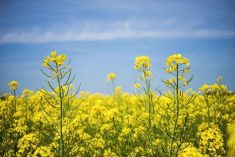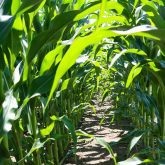Fungal fears sparked by Manitoba’s early season conditions are starting to manifest in some cereal crops.
Reports of ergot have been coming into Manitoba Agriculture, according to provincial cereals specialist Anne Kirk.
“We definitely have seen some ergot this year,” she said. “Rye is most susceptible to ergot. Wheat would be kind of medium on susceptibility, then barley would be least susceptible to ergot in terms of the cereal crops.”
Read Also

How much nitrogen can farmers really cut?
Manitoba fertilizer trials look for nitrification inhibitor sweet spot, to lower greenhouse gas emissions and cost without hurting yield.
Triticale is also susceptible but oats are rarely affected. Ergot can also infect forage grasses including brome, timothy and fescue, although Kirk noted those infections tend to happen earlier in the season.
Why it matters: Ergot can reduce yield and cause grain marketing problems and mycotoxin issues if infected grain reaches the feed bunk.
Ergot overwinters as small, black fungal bodies in soil or stored grain for about a year. In spring or early summer, these bodies sprout into tiny fruiting structures that release spores. Spores are dispersed by wind, insects and rain, infecting open florets of host plants within range.
Within five days of finding a host, the infection moves to its next stage, the honeydew stage, says a Saskatchewan government fact page. This is when sticky, amber liquid starts to ooze from infected cereal florets. The substance attracts dust and pollen, giving the heads a dirty appearance.
As the season advances, infected heads start to show the hard, purple to black ergot structures that are a tell-tale sign of the fungus. These structures replace grain kernels.
Ergot bodies are often more concentrated at field edges and headlands, but can spread throughout the field if contaminated seed or prior infections are the vector.
Cool and damp conditions in late spring and early summer — such as Manitoba saw in May and June — favour the germination of ergot and prolong the flowering period, increasing the risk of infection. Self-pollinated crops like wheat are particularly affected, said David Kaminski, a field crop pathologist with Manitoba Agriculture.
“The reason we’re seeing (ergot) in some of the more self-pollinated crops like wheat (is because) when you have periods of prolonged rainfall, that causes the blooms to stay open for longer,” he said.
Managing risk
A field converted from hay may have a higher risk of ergot due to previous grass infections. Producers are advised to avoid planting fall rye in fields recently used for hay.
Ergot causes yield losses and potential grain downgrading, especially if contamination exceeds 0.25 per cent in wheat, according to Manitoba Agriculture’s website. Producers may want to delay swathing in headland areas to allow wind to clear out ergot bodies and separate these swaths, because they are likely to have higher contamination levels, the province noted.
Mature grain heads exposed to high winds can lose up to 70 per cent of the ergot bodies. Those bodies will then litter the ground, but they are generally not viable beyond a year.
Producers are advised to cut or burn adjacent grasses before they seed to eliminate the fungal foothold, Kirk said. Cleaning seed can remove ergot bodies, she added. Deep planting or storing seed for a year to reduce viability can also help.
Crop rotation plays a pivotal role. Producers should avoid planting wheat after rye and should maintain a gap of at least a year between susceptible crops like rye, triticale, wheat and barley.
There are no resistant varieties or effective fungicides against ergot, but Manitoba Agriculture notes that testing soil for copper levels and applying copper fertilizer can help manage the disease in wheat and barley.
















